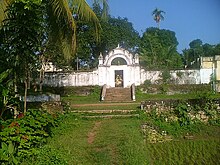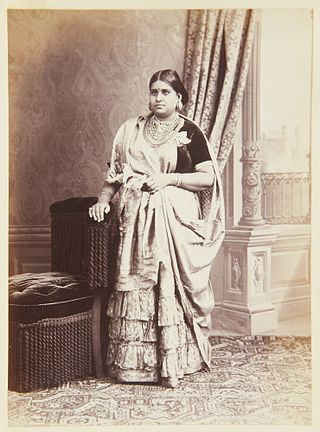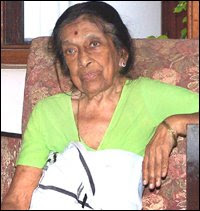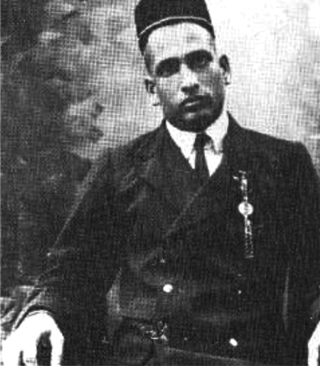
Kilimanoor Palace is a palace located in Kilimanoor, in the Indian state of Kerala. It is the birthplace of painter Raja Ravi Varma and Raghava Varma, the father of king Marthanda Varma. [1]

Kilimanoor Palace is a palace located in Kilimanoor, in the Indian state of Kerala. It is the birthplace of painter Raja Ravi Varma and Raghava Varma, the father of king Marthanda Varma. [1]
The Palace complex covers more than six hectares, and comprises the traditional residential structures of Kerala, like the Nalukettu, small and medium-sized buildings, three ponds, wells and sacred groves (kaavu). Raja Ravi Varma is said to have built and maintained some of the buildings from the proceeds of his paintings. Families related to the Travancore royal house continue to live here.
The royal house at Choottayil, Kilimanoor has a history stretching back more than 300 years, although the oldest buildings are from a much earlier period. However, it was in 1753 that the palace was built in its present form.
The estate of Kilimanoor originally belonged to a Pillai ruling chief and was forfeited to Travancore by Maharaja Marthanda Varma. The estate comprising several villages was then handed over to the family of the father of the King who had come south from Parappanad in Malabar around 1718. [2]
In 1705 (ME 880) the son and two daughters of Ittammar Raja of Beypore Thattarikovilakam, a Parappanad royal house, were adopted into the Royal house of Venad. Ittammar Raja's sister and her sons, Rama Varma and Raghava Varma, settled in Kilimanoor and married the now adopted sisters. Marthanda Varma, the founder of the Kingdom of Travancore, was the son of Raghava Varma. The nephew [3] of Raghava Varma, Ravi Varma Koil Thampuran, married the sister of Marthanda Varma. Their son became known as Dharma Raja Kartika Thirunnal Rama Varma.
In 1740 when an allied force, [4] led by Dutchman Captain Hockert supporting the Deshinganadu King, attacked Venad, an army from Kilimanoor resisted and then defeated them. Although a small victory, this was the first time an Indian army had defeated a European power. In 1753, in recognition of this feat, Marthanda Varma exempted the areas controlled by the Kilimanoor palace [5] from taxes, and granted them autonomous status. [6] The present palace complex was built at this time, together with the Ayyappa temple. [7] for the family deity, Sastha or Ayyapan. [8]
Velu Thampi Dalawa held meetings at Kilimanoor palace while planning uprisings against the British. He handed over his sword at the palace before going into his final battle against the British, and India's first President, Rajendra Prasad received this sword from the palace and it was kept in the National Museum in Delhi. Afterwards the sword was moved to the Napier Museum, Trivandrum.


The Kingdom of Travancore, also known as the Kingdom of Thiruvithamkoor or later as Travancore State, was an Indian kingdom that lasted from c. 1729 until 1949. It was ruled by the Travancore Royal Family from Padmanabhapuram, and later Thiruvananthapuram. At its zenith, the kingdom covered most of the south of modern-day Kerala and the southernmost part of modern-day Tamil Nadu with the Thachudaya Kaimal's enclave of Irinjalakuda Koodalmanikyam temple in the neighbouring Kingdom of Cochin. However Tangasseri area of Kollam city and Anchuthengu near Attingal in Thiruvananthapuram were parts of British India.

Raja Ravi Varma was an Indian painter and artist. His works are one of the best examples of the fusion of European academic art with a purely Indian sensibility and iconography. Especially, he was notable for making affordable lithographs of his paintings available to the public, which greatly enhanced his reach and influence as a painter and public figure. His lithographs increased the involvement of common people with fine arts and defined artistic tastes among the common people. Furthermore, his religious depictions of Hindu deities and works from Indian epic poetry and Puranas have received profound acclaim. He was part of the royal family of erstwhile Parappanad, Malappuram district.

Anizham Thirunal Marthanda Varma was the founding monarch of the southern Indian Kingdom of Travancore from 1729 until his death in 1758. He was succeeded by Rama Varma (1758–98). While he was the heir to the throne, he suggested to his uncle the idea of forming an alliance with the Mughal Nawab of Carnatic. Rama Varma pledged allegiance to the Mughal empire and embraced the title of "Zamindar of Malabar". The feudatory status of Travancore persisted even during the era of Hyder Ali.

Kerala Varma Valiya Koil Thampuran also spelt Kerala Varma Valiya Koilthampuran and known as Kerala Varma, was a Malayalam - language poet and translator who had an equal facility in writing in English and Sanskrit from the Indian state of Kerala. He was a prince of Parappanad, and consort to the Senior Rani of Attingal and Maharani of Travancore, Bharani Thirunal Lakshmi Bayi, intended to father future sovereigns of Travancore, although the couple was childless, necessitating the adoption of Lakshmi Bayi's grand-nieces. Kerala Varma is also known as the Kalidasa of Kerala, and was both brother-in-law and cousin to painter Raja Ravi Varma, also a prince of Parappanad, though from the Kilimanoor branch, whom he presented with his first oil paints. A third Parappanad prince, his grammarian nephew A. R. Raja Raja Varma, is known as the Panini of Kerala.

Thiruvananthapuram District is the southernmost district in the Indian state of Kerala. The district was created in 1949, with its headquarters in the city of Thiruvananthapuram, which is also Kerala's administrative centre. The present district was created in 1956 by separating the four southernmost Taluks of the erstwhile district to form Kanyakumari district. The city of Thiruvananthapuram is also known as the Information technology capital of the State, since it is home to the first and largest IT park in India, Technopark, established in 1990. The district is home to more than 9% of total population of the state.

Kilimanoor is a panchayat and a town in the Chirayinkeezhu taluk of Thiruvananthapuram district in Kerala, India. It is located on MC/SH 1 Road, 33 kilometres (21 mi) North-west of the city of Thiruvananthapuram (Trivandrum), 14 km (8.7 mi) east of Attingal and 20 km (12 mi) east of Varkala.

Pooradam Thirunal Sethu Lakshmi Bayi CI was the monarch, though designated as the Regent due to British policy, of the Kingdom of Travancore in southern India between 1924 and 1931. She, along with her younger cousin, Moolam Thirunal Sethu Parvathi Bayi, were adopted into the Travancore royal family and were the granddaughters of the celebrated painter, Raja Ravi Varma.

Parappanangadi is a major town and a municipality in Tirurangadi taluk of Malappuram district, Kerala, India. It is a coastal town located close to the Arabian sea.
Rajah Rama Varma was the ruler of the Indian kingdom of Venad, later known as Travancore, in the modern day state of Kerala, India between 1724 and 1729, having succeeded his brother Unni Kerala Varma. He is better known as the uncle of Maharajah Padmanabha Dasa Vanchi Pala Marthanda Varma Kulasekhara Perumal, the "maker of modern Travancore". He was born into the Royal Family of Kolathunadu, as the second son of Rajah Ittamar of Thattari Kovilakam. It was princes from the Parappanadu family who customarily married Kolathunadu princesses. Rama Varma's entire family, including himself, two sisters and his elder brother Unni Kerala Varma, were adopted into the Venad house as members of the Travancore Royal Family by Rajah Ravi Varma, nephew of Umayamma Rani due to the failure of heirs there. Ittammar Raja's sister and her sons, Rama Varma and Raghava Varma, settled in Kilimanoor and married the now adopted sisters. Of the adopted sisters, one died soon after her adoption while the other was the mother of the Maharajah Marthanda Varma.

The Travancore royal family was the ruling house of the Kingdom of Travancore.The Travancore royal family signed a treaty with the British in 1788, thereby adopting British dominance. Later, in 1805, they revised the treaty, leading to a diminution of royal authority and the loss of political independence for Travancore. They had to give up their ruling rights over the common people in 1949 when Travancore were forced to merge with Independent India and their political pension privileges were abolished in 1971.

Maharani Bharani Thirunal Lakshmi Bayi CI was the Senior Rani of Travancore from 1857 till her death in 1901. Her consort was the famous poet and writer, styled the father of Malayalam literature, Sri Kerala Varma Valiya Koil Thampuran.
Chirayinkeezhu Taluk is a Taluk (tehsil) in Thiruvananthapuram district in the Indian state of Kerala. It is shares border with Varkala Taluk in North and with Thiruvananthapuram Taluk in South. It comprises 12 panchayats and Attingal Municipality. Chirayinkeezhu taluk is the birthplace of a host of illustrious personalities like the painter Raja Ravi Varma, the great poet and social reformer Kumaran Asan and Prem Nazir etc.
Parappanad was a former feudal city-state in Malabar, India. The headquarters of Parappanad Royal family was at the town Parappanangadi in present-day Malappuram district. In 1425, the country divided into Northern Parappanad and Southern Parappanad. Southern Parappanad included parts of Tirurangadi Taluk and the town Parappanangadi. Northern Parappanad included Panniyankara, Beypore, and Cheruvannur of Kozhikkode Taluk. Parappanad royal family is a cousin dynasty of the Travancore royal family.

Raja Raja Varma Koil Thampuran, also known as Raja Raja Varma, was a Malayalam language poet and translator from the Indian state of Kerala who had an equal facility in writing in English and Sanskrit. He was born in Neerazhi Palace, Changanassery. He was part of the royal family of erstwhile Parappanad, Malabar.

Rani Bharani Thirunal Parvathi Bayi was a junior Rani of Travancore as known as ' Attingal Elaya Rani ' Her consort was Kilimanoor Kerala Varma Koyi Thampuran. Parvathi Bayi was born in 1850 as the daughter of Bharani Thirunal Amma Thampuran of Utsava Madom Palace in Mavelikara.

Maharani Karthika Thirunal Lakshmi Bayi (1916-2008) was the only sister of the last ruling Maharajah of Travancore, Sree Chithira Thirunal Balarama Varma and of his successor, Sree Uthradom Thirunal Marthanda Varma. Under the matrilineal Marumakkathayam system of inheritance prevalent in the kingdom of Travancore, it was her children who were heirs to the throne. She therefore held a very special place in the Travancore court, superior to the Maharaja's wives, and was termed the Rani of Attingal in her own right. In 2013, her only surviving son duly succeeded his uncles as titular Maharaja of Travancore and is known as Moolam Thirunal Rama Varma.

Moolam Thirunal Sethu Parvathi Bayi (1896–1983), better known as Amma Maharani, was the Junior Maharani (Queen) of Travancore as well as a promoter of Indian Classical music. She was the mother of Chithira Thirunal Balarama Varma, the last King of Travancore. She was the president of the National Council of Women in India in 1938–1944.

Koyi Thampuran was the title of the Prince Consorts of the Queens and Princesses of Travancore. The Koyi Thampurans' gained prominence and prestige in Kingdom of Travancore as they were the fathers of the then reigning Kings. In Travancore, there were ten clans of Koyi Thampurans. The most ancient were the ones settled at Kilimanoor ; others were Kirthipuram, Pallam, Paliyakkara and Nirazhi, Ananthapuram, Chemprol, Cherukol, Karazhma and Vatakkemadham.

Neerazhi Palace was the royal palace of the Thekkumkur kingdom. Palace is located at Puzhavathu in Changanassery. The palace was used by the Thekkumkur dynasty until 1750 and later by the Parappanad dynasty who settled in Changanassery from North Malabar. It was here that the last king of Thekkumkur, Aditya Varman Manikandan escaped to Nattassery of Kottayam in the Travancore invasion of 1790. The Neerazhi palace was earlier known as Neerazhikettu.

Lakshmipuram Palace is the royal palace of the Parappanad royal families at Changanassery. Palace is located at Puzhavathu near to Kavil Bhagavathy Temple. The Lakshmipuram Palace was built in 1811 AD by Travancore ruler Maharani Ayilyom Thirunal Gouri Lakshmi Bayi (1791–1815) on behalf of the family of her husband Raja Raja Varma Valiya Koil Thampuran. Until then, the royal family at the Neerazhi Palace in Changanacherry had been moved to newly built Lakshmipuram Palace. It was the seat of the royal family of Koi thampurans and has produced many illustrious writers such as Raja Raja Varma Koil Thampuran, Kerala Varma Valiya Koil Thampuran and A. R. Raja Raja Varma. Noted Malayalam singer and classical musician L. P. R. Varma also hails from this palace.
This article includes a list of general references, but it lacks sufficient corresponding inline citations .(November 2012) |
*S.A.V.SMARAKA VAIDHYA SALA,TAZHAVA,KOLLAM[DIST]